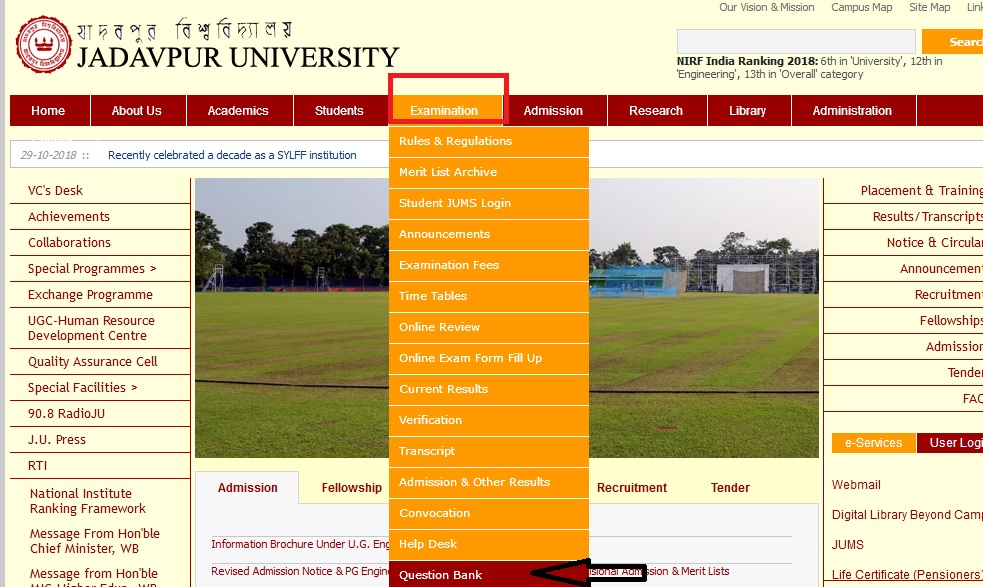Printing Material Science–I B.E Question Paper : jaduniv.edu.in
Name of the University : Jadavpur University
Department : Printing Engineering
Degree : B.E
Subject Name : Printing Material Science – I
Year/Sem : I/II
Website : jaduniv.edu.in
Document Type : Model Question Paper
Download Model/Sample Question Paper : https://www.pdfquestion.in/uploads/dspace.jdvu.ac.in/5440-Printing%20Material%20Science%20-%20I.pdf
Jadavpur Printing Material Science Question Paper
First Engg. (Printing) Examination, 2007 :
(2nd Semester)
Printing Material Science – I :
Time : Three hours
Full Marks : 100
Related : Quality Management In Construction B.E Question Paper : www.pdfquestion.in/6457.html
Model Questions
1. Answer any 5 questions (Each carry 3 marks). 3×5=15
(a) What is surface tension? What is the limit of surface tension?
(b) What is viscosity coefficient? What is the limit of it?
(c) What do you mean by Holography?
(d) What is the difference between conduction and convection?
(e) Write down the less of Lasers.
(f) Write down the application of Fibre optics.

2. Answer all questions. (Each carry 1 mark) 10×1=10
(i) What is the limit of Stefan – Boltzmann’s constant?
(ii) Write down Poiseuille’s equation?
(iii) What is fluidity?
(iv) Write down Stoke’s law.
(v) What is paramagnetic substance?
(vi) What is forbidden gap in energy band?
(vii) Give example of piezoelectric materials.
(viii) What is hysteresis?
(ix) What is the full form of LASER?
(x) What are the regions of optical fibre?
3. Answer any 5 quesitons. (Each carry 15 marks)
(i) Write down the relation between surface tension and temperature. Derive the relation between surface tension and vapor pressure. A drop of water, 0.5 cm in diameter, is split up into 125 times drops. Find the increase in surface energy (nH2O = 70 dynes/cm). 2+6+7=15
(ii) What is the relation between viscosity and temperature for liquid and gases ?
Heptane (r=0.72) flows through a viscometer in 60 sec while some volume of water requires 105 sec at 20°C. Calculate the absolute viscosity of heptane if that of water is 0.01002 poise. What is Reynold’s no. ; what is turbulent type of flow? 4+7+4=15
(iii) What do you mean by conduction? Determine the rate of heat loss Q, through a wall of red brick (k = 0.5W/mK) ; 5 m in length, 4 m in height and 0.2 m in thickness, if the wall surfaces are mentained at 90°C and 30°C respectively. What absorbing power of a substance? What is emission and absorption of radiation? 2+7+2+4=15
(iv) Write down the difference between semiconductor and insulator in respect of bond theory. 4
Write down the working principle of laser. 3 Write down the characteristics of laser. 4
Briefly describe stimulated emission of light laser 4
(v) Write down the specially of optical Fibres. 5
Write down the working principle of optical Fibre. 5
What is acceptance cone and numerical aperture of optical Fibre. 5
(vi) Write short notes on : (any three) 5×3=15
(a) Ferrimagnetism
(b) Hysteresis
(c) Diamagnetism
d) Paramagnetism
(e) Ferromagnetism.
(vii) Write down the basic principle of Holography? Describe Holography.
Write down the application of Holography.
What is extrinsic semiconductor and what is intrinsic semiconductor? 3+5+4+3=15
Printing Design
Attempt any five questions. :
1 (a) What are the various types of fits according to Indian standard? Explain them with the help of neat diagrams. 8
(b) What is the significance of preferred number? 3
(c) Define “interchangeability” and discuss its importance. 4
(d) The dimensions of the mating parts according to basic hole system, are given as follows :
Hole : 37.500 mm Shaft : 37.470 mm 37.523 mm 37.445 mm
Find the hole tolerance, shaft tolerance and minimum allowance, maximum allowance. 5
2. (a) What are the advantages and disadvantages of thread joints? 4
(b) What do you understand by the Single Start and double Start thread? 2
(c) Define the following terms with neat sketches.
(i) major diameter (ii) minor diameter
(iii) pitch diameter (iv) pitch
(v) angle of thread (vi) lead. 8
(d) A lever loaded safety valve has a diameter of 100mm. and the blow off pressure is 1.6 N/mm2. The fulcrum of the lever is screwed into the C.I. body of the cover. If the permissible tensile stress is limited to 50 Mpa and the leverage ratio is 8. Find the diameter of the threaded part of the fulcrum and select the size of the bolt. 6
3. (a) How the shaft is designed when it is subjected to twisting moment only? 10
(b) A shaft made of mild steel is required to transmit 100 kw at 300 r.p.m. The supported length of the shaft is 3 metres.
It carries two pulleys each weighing 1500N supported at a distance of 1 metre from the ends respectively. The safe value of stress = 60N/mm2. Draw the load diagram and determine the diameter of the shaft. 10
4. (a) Define the terms load, stress and strain. Discuss the various types of stresses and strain. 6
(b) What is meant by working stress and how it is calculated from the ultimate stress or yield stress of a material? What will be the factor of safety in each case for different types of loading? 6
(c) The piston rod of a steam engine is 50 mm in diameter and 600mm long. The diameter of piston is 400mm. and the maximum steam pressure is 0.9 N/mm2. Find the compression of the piston rod,if the young’s modulus for the material of the piston rod is 210KN/ mm2. 8
5. (a) What is the function of a coupling? What are the requirements of a good coupling? 4
(b) How do you classify couplings? 2